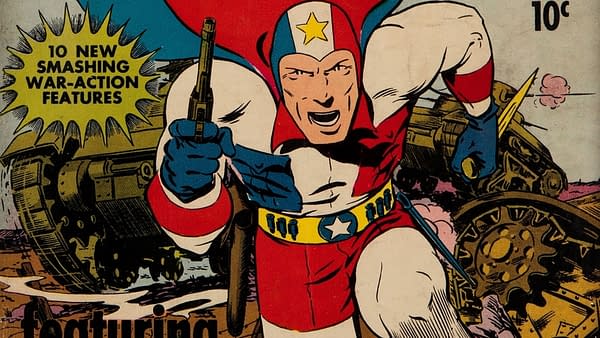Victory Comics Featuring Bill Everett’s The Conqueror, up for Auction
Bill Everett’s The Conqueror debuted in Victory Comics from Hillman Periodicals as a superhero transformed by cosmic rays.
When Writer’s Digest announced that former Funnies, Inc editor John H. Compton would be editing two new titles for Hillman Periodicals (Victory Comics and Air Fighters Comics), they only got the details half right: “There are no super-men in these. The emphasis is on story and character values.” While Air Fighters Comics, which introduced Airboy in its second issue, is certainly not a superhero comic book, Victory Comics is another matter entirely. That series features a character called the Conqueror, very decidedly a superhero, created by the legendary Bill Everett of Sub-Mariner fame. An overlooked character from one of the most important creators in comic book history, there’s a Victory Comics #2 and #3 up for auction in the 2023 May 18 The War Comics Showcase Auction #40223 at Heritage Auctions.

Interestingly, the Conqueror’s origin was told in a two-part text story in the first two issues of Victory Comics. Like the earlier superhero the Ray, the Conqueror’s powers come from cosmic rays: A pilot named Daniel Lyons was attempting to fly from California to New York, but his plane crashed in the Rocky mountains due to bad weather. He was found by Professor James Norton, whom the papers of the day called “the cosmic ray professor,” and taken to Norton’s laboratory. Professor Norton was likely inspired by Nobel Prize-winning physicist Robert Andrews Millikan, who coined the term “cosmic rays” and wrote a book about the subject that generated significant newspaper attention in 1940.
Norton explains to Lyons, “I was afraid you wouldn’t make it. So I applied the benefits of the ray — and have been doing it now every day ever since you’ve been here. I’ve been feeding you with juices energized by cosmic rays. I’ve been baking your body with my special cosmic ray lamp. See it there? Your body has been absorbing the energy of this ray. Your metabolism has increased tremendously already. You’ll find, once you’re up and about — which should be tomorrow — that you will have improved a hundred percent, both physically and mentally.”
Beginning with issue #3, Victory Comics contained a brief letter column with answers to reader emails by editor John H. Compton (presumably). Something of a rarity in the Golden Age, one eyebrow-raising letter in this issue had a reader taking issue with the focus on what he termed as “England’s War” and preferred that Victory Comics hero The Conqueror take on Stalin in Russia. While this issue hit the newsstands several weeks before the US’s declaration of war, Compton replied that this was not just England’s war, but ours as well, and now even Stalin’s war. World events were moving both dramatically and quickly through the second half of 1941, and one interesting coincidence would be seized on by Compton throughout the remainder of this short series.
The first issue of Victory Comics hit the newsstands around March 16, 1941 according to copyright records. It’s an obvious enough name for a WWII-era comic book title, certainly. But a short time later, the “V for Victory” media campaign was launched in England and spread like wildfire. “V for Victory” is well-remembered symbolism from WWII, but that symbolism has fascinating origins. The V symbol was originally the lynchpin of a British propaganda campaign launched by BBC assistant news editor Douglas Ritchie. Via regular radio broadcasts that began on July 20, 1941 and accompanying newspaper coverage around the globe, Ritchie assumed the identity “Colonel Britton”, calling for the formation of what he called the “V-Army” among the citizens of territory occupied by the Nazis as well as everywhere in the world. The V-Army was called on to make the V symbol on walls, doors, and pavement everywhere in occupied territories as a symbol of a secret but massive resistance. Further, they were also to tap out the V sign in morse code — three dots and a dash — to embolden fellow resisters and strike fear into Germany. Finally, of course, raising two fingers of the hand to flash a V sign was also encouraged. This form of the V sign was further popularized with its use by Winston Churchill. Finally, the V-Army was asked to be ready to take more direct action. Colonel Britton’s identity was kept a secret until he was revealed to be Ritchie in 1945.
Victor Fox’s V-Comics would later build its V-Man feature around these details, and Compton saw the obvious connection to his comic title by the time Victory Comics #3 hit the newsstands, making a point of having Victory Comics jump on the trend in what would become the final two issues of the series. While Victory Comics featured a superhero in the Conqueror despite what Compton had said about the series, he and Everett firmly tied the title to the war. An overlooked series by historically important creators, there’s a Victory Comics #2 and #3 up for auction in the 2023 May 18 The War Comics Showcase Auction #40223 at Heritage Auctions.

Affiliates of Bleeding Cool buy from and/or consign to Heritage Auctions.
For all the latest Comics News Click Here
For the latest news and updates, follow us on Google News.

